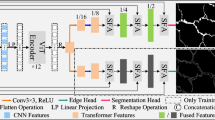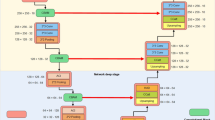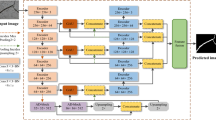Abstract
In recent years, the demand for automatic crack detection has increased rapidly. Due to the particularity of crack images, that is, the proportion of cracks in the entire images is very small, and some cracks in the image are particularly slender and light, it brings challenge for automatic crack detection. In this paper, we propose an end-to-end pixel-level crack segmentation network, named as “Crack-Att Net”. In our approach, firstly, an encoder network is used to extract the crack features; then, crack features generated by the encoder and decoder networks at the same scale are pairwisely fused through a parallel attention mechanism added for accurately locating the cracks; finally, the fused crack feature maps at all scales are further fused into a multi-scale feature-fusion map for crack detection. Experiments results on three existing datasets and an augmented dataset show that our proposed Crack-Att Net outperforms the current state-of-the-art methods.












Similar content being viewed by others
References
Abdel-Qader I, Abudayyeh O, Kelly ME (2003) Analysis of edge-detection techniques for crack identification in bridges. J Comput Civ Eng 17:255–263. https://doi.org/10.1061/(ASCE)0887-3801(2003)17:4(255)
Badrinarayanan V, Kendall A, Cipolla R (2017) Segnet: a deep convolutional encoder-decoder architecture for image segmentation. IEEE Trans Pattern Anal Mach Intell 39:2481–2495. https://doi.org/10.1109/TPAMI.2016.2644615
Benz C, Debus P, Ha HK, Rodehorst V (2019) Crack segmentation on UAS-based imagery using transfer learning. 2019 International Conference on Image and Vision Computing New Zealand (IVCNZ), Paris, France, pp 1–6. https://doi.org/10.1109/IVCNZ48456.2019.8960998
Cho H, Yoon H-J, Jung J-Y (2018) Image-based crack detection using crack width transform (CWT) algorithm. IEEE Access 6:60100–60114. https://doi.org/10.1109/ACCESS.2018.2875889
Fan R, Bocus MJ, Zhu Y et al (2019) Road crack detection using deep convolutional neural network and adaptive thresholding. 2019 IEEE Intelligent Vehicles Symposium (IV) 474–479. https://doi.org/10.1109/IVS.2019.8814000
Garcia-Garcia A, Orts-Escolano S, Oprea S et al (2017) A survey on deep learning techniques applied to semantic segmentation. Appl Soft Comput 70:41–65. https://doi.org/10.1016/j.asoc.2018.05.018
Girshick R (2015) Fast r-cnn: towards real-time object detection with region proposal networks. Adv Neural Inf Proces Syst 1440–1448. https://doi.org/10.1109/TPAMI.2016.2577031
He K, Zhang X, Ren S, Sun J (2016) Deep residual learning for image recognition. 2016 IEEE Conference on Computer Vision and Pattern Recognition (CVPR), Las Vegas, NV, pp 770–778. https://doi.org/10.1109/CVPR.2016.90
Hu J, Shen L, Sun G (2018) Squeeze-and-excitation networks. 2018 IEEE/CVF Conference on Computer Vision and Pattern Recognition, Salt Lake City, UT, pp 7132–7141. https://doi.org/10.1109/CVPR.2018.00745
Ioffe S, Szegedy C (2015) Batch normalization: accelerating deep network training by reducing internal covariate shift. Proceedings of the 32nd International Conference on Machine Learning 37:448–456. https://dl.acm.org/doi/10.5555/3045118.3045167
Kaseko MS, Ritchie SG (1993) A neural network-based methodology for pavement crack detection and classification. Transportation Research Part C: Emerging Technologies 1:275–291
Kingma DP, Ba J (2014) Adam: a method for stochastic optimization. arXiv preprint arXiv:14126980. https://arxiv.org/abs/1412.6980
Krizhevsky A, Sutskever I, Hinton GE (2017) Imagenet classification with deep convolutional neural networks. Commun ACM 60:84–90. https://doi.org/10.1145/3065386
Li Q, Liu X (2008) Novel approach to pavement image segmentation based on neighboring difference histogram method. 2008 Congress on Image and Signal Processing, Sanya, pp 792–796. https://doi.org/10.1109/CISP.2008.13
Lim RS, La HM, Sheng W (2014) A robotic crack inspection and mapping system for bridge deck maintenance. IEEE Trans Autom Sci Eng 11:367–378. https://doi.org/10.1109/TASE.2013.2294687
Lin T-Y, Goyal P, Girshick R et al (2020) Focal loss for dense object detection. Focal loss for dense object detection. IEEE Trans Pattern Anal Mach Intell 42:318–327. https://doi.org/10.1109/TPAMI.2018.2858826
Liu W, Anguelov D, Erhan D et al (2016) Ssd: single shot multibox detector. European Conference on Computer Vision 21–37. https://doi.org/10.1007/978-3-319-46448-0_2
Liu Y, Cheng M-M, Hu X et al (2019) Richer convolutional features for edge detection. IEEE Trans Pattern Anal Mach Intell 41:939–1946. https://doi.org/10.1109/TPAMI.2018.2878849
Liu K, Han X, Chen BM (2019) Deep learning based automatic crack detection and segmentation for unmanned aerial vehicle inspections. 2019 IEEE International Conference on Robotics and Biomimetics (ROBIO), Dali, pp 381–387. https://doi.org/10.1109/ROBIO49542.2019.8961534
Liu Y, Yao J, Lu X et al (2019) DeepCrack: a deep hierarchical feature learning architecture for crack segmentation. Neurocomputing 338:139–153. https://doi.org/10.1016/j.neucom.2019.01.036
Liu Y, Li Q, Yuan Y et al (2021) ABNet: adaptive balanced network for multiscale object detection in remote sensing imagery. IEEE Trans Geosci Remote Sens 60:1–14. https://doi.org/10.1109/TGRS.2021.3133956
Liu H, Miao X, Mertz C, et al (2021) CrackFormer: transformer network for fine-grained crack detection. 2021 IEEE/CVF International Conference on Computer Vision (ICCV), Montreal, QC, pp 3763–3772. https://doi.org/10.1109/ICCV48922.2021.00376
Long J, Shelhamer E, Darrell T (2015) Fully convolutional networks for semantic segmentation. Proceedings of the IEEE conference on computer vision and pattern recognition, pp 3431–3440
Medina R, Llamas J, Gómez-García-Bermejo J et al (2017) Crack detection in concrete tunnels using a gabor filter invariant to rotation. Sensors 17:1670. https://doi.org/10.3390/s17071670
Mohan A, Poobal S (2018) Crack detection using image processing: a critical review and analysis. Alex Eng J 57:787–798. https://doi.org/10.1016/j.aej.2017.01.020
Nair V, Hinton GE (2010) Rectified linear units improve restricted boltzmann machines. Proceedings of the 27th International Conference on International Conference on Machine Learning, pp 807–814. https://dl.acm.org/doi/10.5555/3104322.3104425
Oliveira H, Correia PL (2009) Supervised crack detection and classification in images of road pavement flexible surfaces. Recent Advances in Signal Processing, pp 159–184. https://doi.org/10.5772/7448
Park S, Bang S, Kim H, Kim H (2019) Patch-based crack detection in black box images using convolutional neural networks. J Comput Civ Eng 33:04019017. https://doi.org/10.1061/(ASCE)CP.1943-5487.0000831
Qian N (1999) On the momentum term in gradient descent learning algorithms. Neural Netw 12:145–151. https://doi.org/10.1016/S0893-6080(98)00116-6
Qu Z, Bai L, An S-Q et al (2016) Lining seam elimination algorithm and surface crack detection in concrete tunnel lining. Journal of Electronic Imaging 25:063004. https://doi.org/10.1117/1.JEI.25.6.063004
Redmon J, Divvala S, Girshick R, Farhadi A (2016) You only look once: unified, real-time object detection. Proceedings of the IEEE conference on computer vision and pattern recognition, Las Vegas, NV, pp 779–788. https://doi.org/10.1109/CVPR.2016.91
Ren S, He K, Girshick R, Sun J (2015) Faster r-cnn: towards real-time object detection with region proposal networks. IEEE Trans Pattern Anal Mach Intell 39:1137–1149. https://doi.org/10.1109/TPAMI.2016.2577031
Ronneberger O, Fischer P, Brox T (2015) U-net: convolutional networks for biomedical image segmentation. Medical Image Computing and Computer-Assisted Intervention – MICCAI 2015. MICCAI 2015. Lecture Notes in Computer Science, vol 9351. Springer, Cham. https://doi.org/10.1007/978-3-319-24574-4_28
Ruder S (2016) An overview of gradient descent optimization algorithms. arXiv preprint arXiv:160904747. http://arxiv.org/abs/1609.04747
Shi Y, Cui L, Qi Z et al (2016) Automatic road crack detection using random structured forests. IEEE Trans Intell Transp Syst 17:3434–3445. https://doi.org/10.1109/TITS.2016.2552248
Simonyan K, Zisserman A (2014) Very deep convolutional networks for large-scale image recognition. 3rd International Conference on Learning Representations (ICLR 2015), Computational and Biological Learning Society, pp 1–14
Subirats P, Dumoulin J, Legeay V, Barba D (2006) Automation of pavement surface crack detection using the continuous wavelet transform. 2006 International Conference on Image Processing, Atlanta, GA, pp 3037–3040. https://doi.org/10.1109/ICIP.2006.313007
Sudre CH, Li W, Vercauteren T, et al (2017) Generalised dice overlap as a deep learning loss function for highly unbalanced segmentations. Deep Learning in Medical Image Analysis and Multimodal Learning for Clinical Decision Support. DLMIA ML-CDS 2017. Lecture Notes in Computer Science, vol 10553. Springer, Cham. https://doi.org/10.1007/978-3-319-67558-9_28
Szegedy C, Liu W, Jia Y et al (2015) Going deeper with convolutions. Proceedings of the IEEE conference on computer vision and pattern recognition, pp 1–9. https://doi.org/10.1109/CVPR.2015.7298594
Wang G, Zhuang Y, Chen H et al (2022) FSoD-Net: full-scale object detection from optical remote sensing imagery. IEEE Trans Geosci Remote Sens 60:1–18. https://doi.org/10.1109/TGRS.2021.3064599
Woo S, Park J, Lee J-Y, Kweon IS (2018) Cbam: convolutional block attention module. Proceedings of the European conference on computer vision (ECCV), pp 3–19. https://doi.org/10.1007/978-3-030-01234-2_1
Xie S, Tu Z (2015) Holistically-nested edge detection. Proceedings of the IEEE international conference on computer vision, pp 1395–1403. https://doi.org/10.1109/ICCV.2015.164
Zeiler MD (2012) Adadelta: an adaptive learning rate method. arXiv preprint arXiv:12125701. https://arxiv.org/abs/1212.5701
Zhang L, Yang F, Zhang YD, Zhu YJ (2016) Road crack detection using deep convolutional neural network. 2016 IEEE International Conference on Image Processing (ICIP), pp 3708–3712. https://doi.org/10.1109/ICIP.2016.7533052
Zou Q, Zhang Z, Li Q et al (2018) Deepcrack: learning hierarchical convolutional features for crack detection. IEEE Trans Image Process 28:1498–1512. https://doi.org/10.1109/TIP.2018.2878966
Zou Q, Cao Y, Li Q et al (2012) CrackTree: automatic crack detection from pavement images. Pattern Recogn Lett 33:227–238. https://doi.org/10.1016/j.patrec.2011.11.004
Acknowledgements
This research was funded by the National Key Research and Development Program of China (No. 2021YFC2902000). Thanks are given to the anonymous reviewers for their careful reviews and detailed comments.
Author information
Authors and Affiliations
Corresponding author
Ethics declarations
Conflict of interest
The authors declare that they have no conflicts of interest.
Additional information
Publisher's note
Springer Nature remains neutral with regard to jurisdictional claims in published maps and institutional affiliations.
Rights and permissions
Springer Nature or its licensor (e.g. a society or other partner) holds exclusive rights to this article under a publishing agreement with the author(s) or other rightsholder(s); author self-archiving of the accepted manuscript version of this article is solely governed by the terms of such publishing agreement and applicable law.
About this article
Cite this article
Xu, N., He, L. & Li, Q. Crack-Att Net: crack detection based on improved U-Net with parallel attention. Multimed Tools Appl 82, 42465–42484 (2023). https://doi.org/10.1007/s11042-023-15201-7
Received:
Revised:
Accepted:
Published:
Issue Date:
DOI: https://doi.org/10.1007/s11042-023-15201-7




